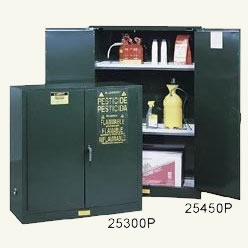Autumn is the time to prepare a safe holding area for unused supplies of gardening pesticides and fertilizers. Proper storage (Figure 1) is important for many reasons, including preservation of the environment, protection of human health, and maintenance of chemical efficacy.

Figure 1 - Pesticide & fertilizer storage cabinet
A winter storage area or facility for pesticides and fertilizers should:
- be secure
- be well-ventilated
- be well-lit when in use
- allow materials to remain "high and dry"
- be protected from extreme heat and cold
- be spacious enough to allow for separation of herbicides, fungicides, insecticides, and fertilizers
- be enclosed in such a manner that leaks and/or spills may be contained and cleaned without compromising the soil and water quality in the vicinity.
The storage area must be secure from unwanted visitors, both people and animals! Good lighting and ventilation are important to the personal health of the user(s) of the facility. In addition, proper ventilation can prevent volatile chemicals from contaminating other materials in storage. Separation of chemicals in storage by type is additional insurance against contamination. Flammable liquids must be stored outside living areas and away from ignition sources. Dampness is a serious problem, as it reduces the shelf life of many chemicals and causes metal and paper containers to degrade. It is imperative that storage areas be secure from flooding. Temperature extremes can also affect product shelf life. In addition, heat increases the volatility of stored chemicals while freezing can cause some types of containers to rupture. If specific temperature ranges are required for proper storage, they will be found on the product label. Finally, the site must allow for containment of spills and/or leaks. Ideally, clean-up materials (absorbents, water) will be near.
Chemicals and the containers in which they are to be held must be in good condition. Whenever possible, pesticides and fertilizers should be kept in their original containers. In all cases, a legible product label must be attached to the chemical container. Never transfer excess pesticide or fertilizers to an empty food container.
Do not store pesticides with or near food, medicine, or cleaning supplies. An updated storage inventory allows for keeping track of what has been placed in storage and also helps in planning purchases next season. Useful records may include product name, active ingredient, date of purchase, and date and volume stored.
One way to minimize storage problems is to plan ahead, and buy pesticides and fertilizers one season at a time. The small-volume containers that seemed expensive in the spring may, in fact, be the "best buy" in the long run.
Fertilizers may be applied by broadcasting granular fertilizer over the entire garden according to directions on the fertilizer bag and tilling it into the top 6 inches of soil. This can be wasteful, however, if fertilizer is spread in areas where there are no plants, and it can leach through the soil and contribute to water pollution. Another method, called banding, is more efficient although it takes a bit more work. Narrow bands of fertilizer are placed in furrows 2 to 3 inches from the seeds in the row and slightly deeper than the seeds to provide a buffer zone.
Side dressing is the application of dry fertilizer after plants are up and growing. Scatter fertilizer on both sides of the row 6 to 8 inches from the plants. Rake it into the soil and water thoroughly. The most suitable use for soluble fertilizers is to be mixed with water and applied to plants when transplanting them. The nutrients are rapidly available to help the plant adjust and begin growth.
